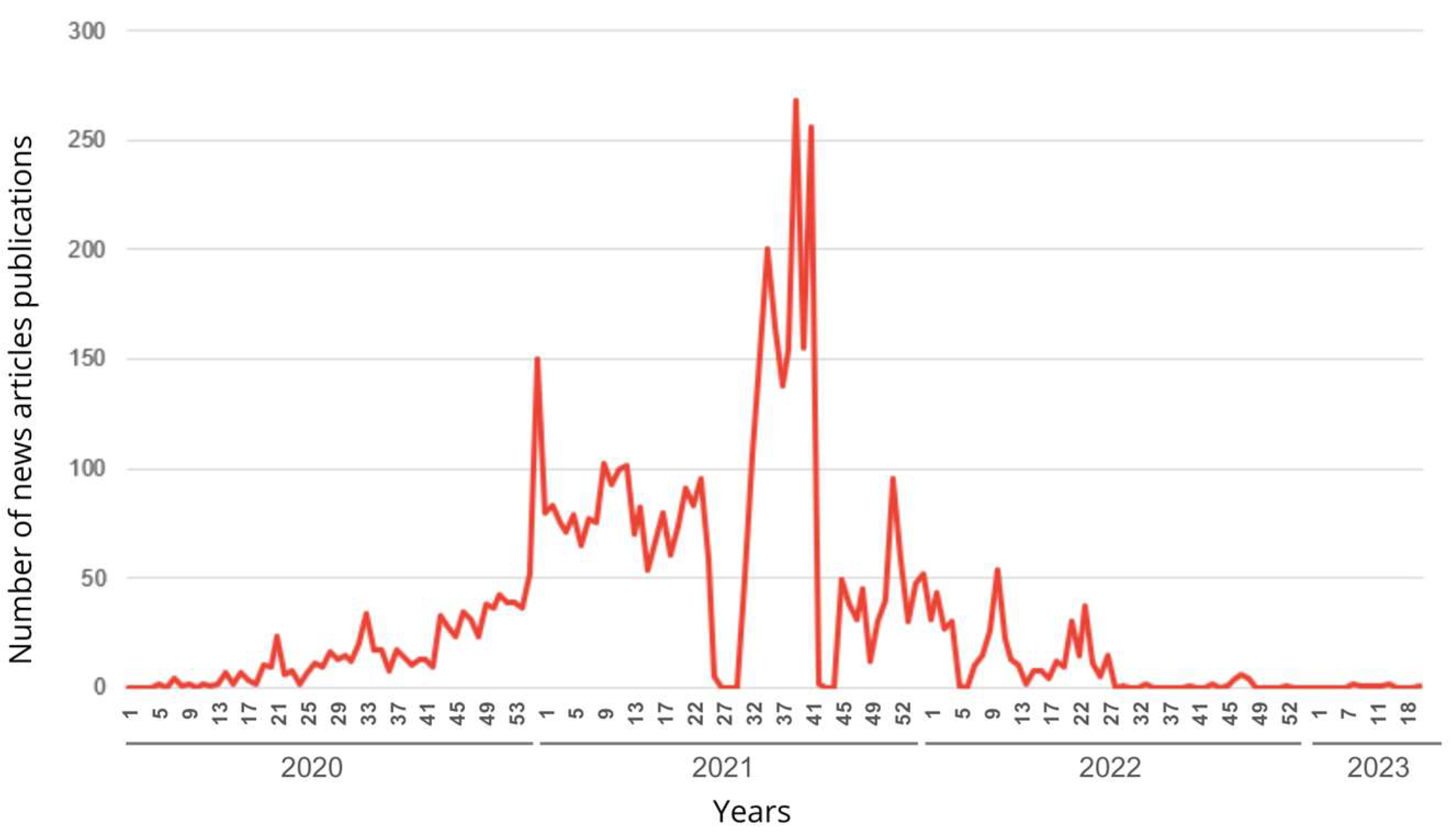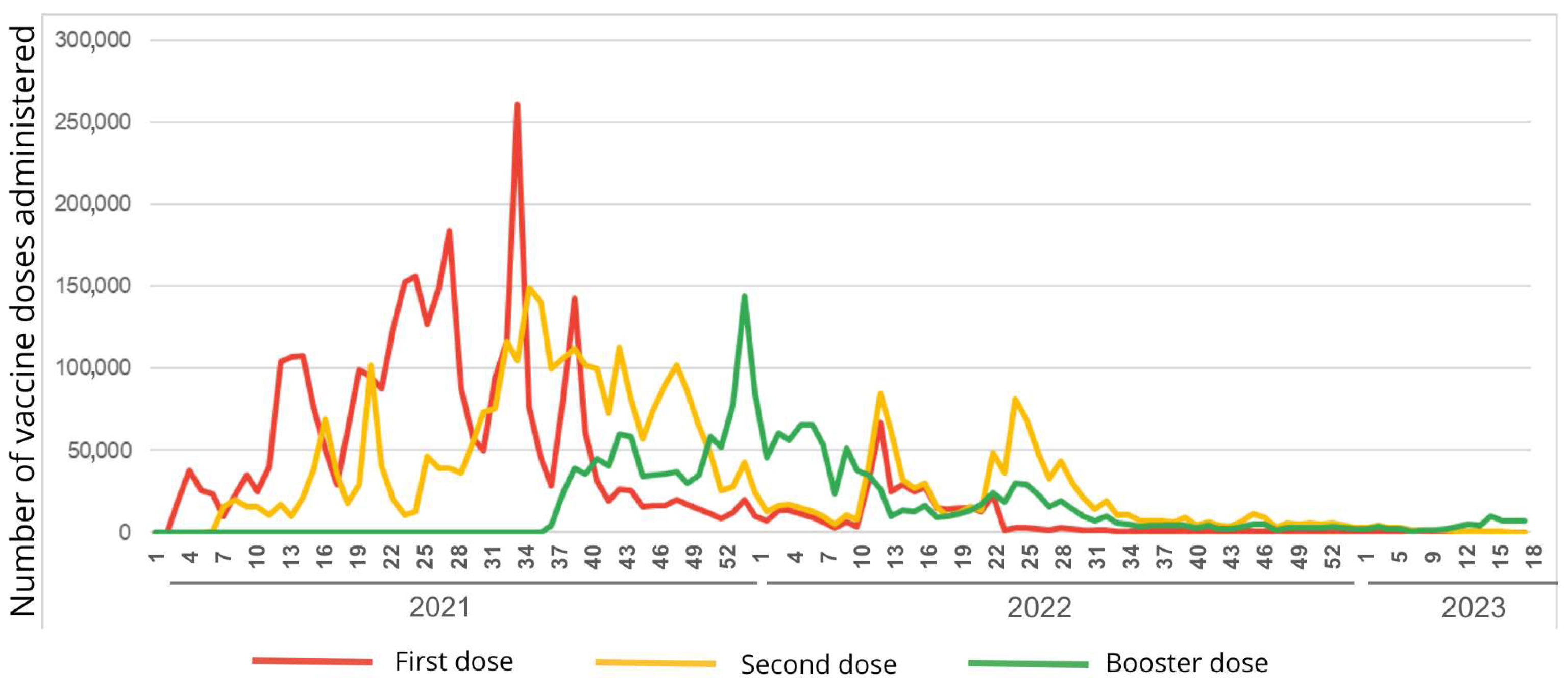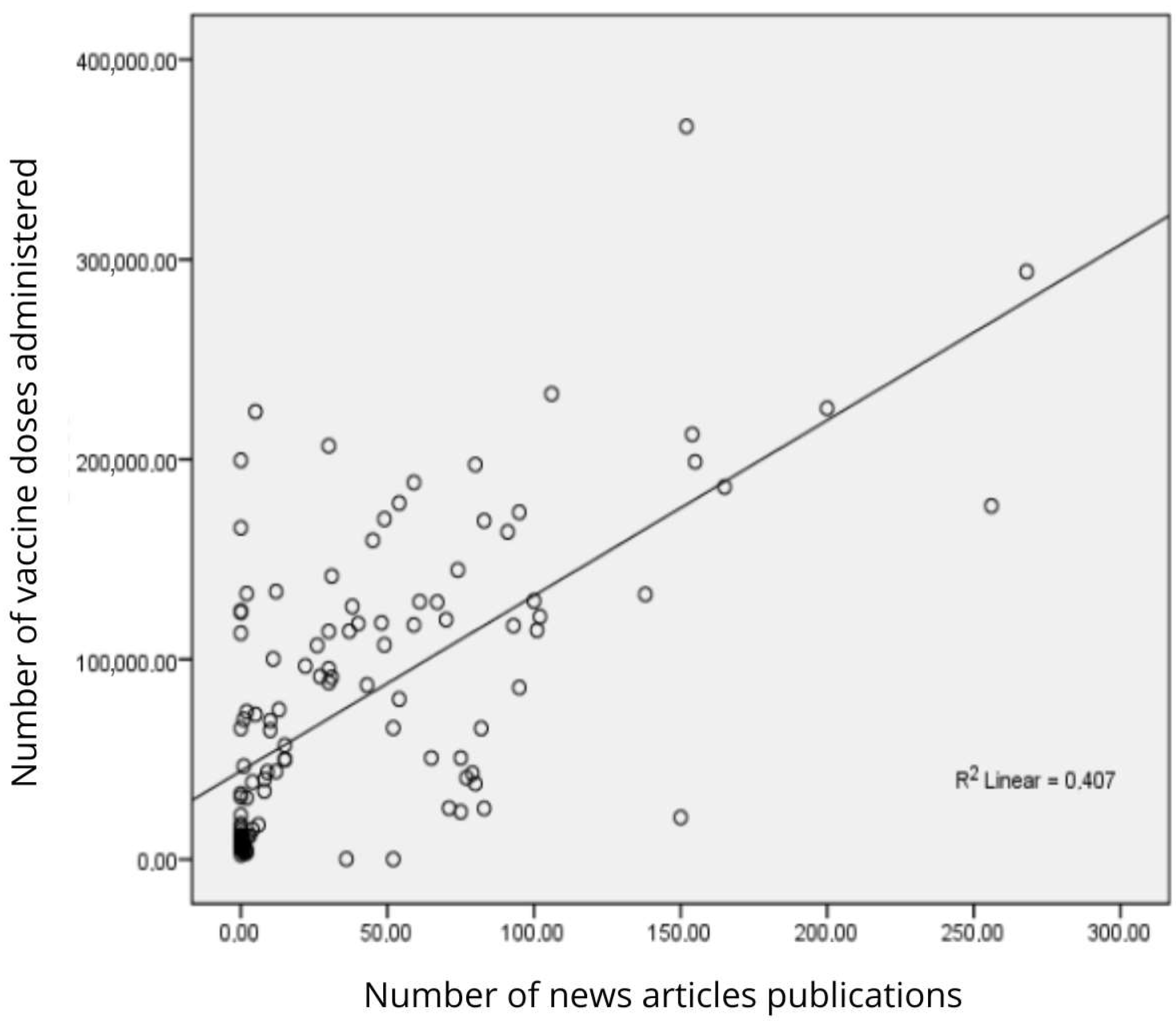Public Health in the Headlines: A Study of Media Behavior on Discourses on Vaccination During COVID-19
Abstract
1. Introduction
2. Materials and Methods
2.1. Study Design
2.2. Research Setting
2.3. Data Analysis
3. Results
4. Discussion
4.1. The Findings in the Journalist Articles
4.2. The Information Contained in the COVID-19 Panel—Espírito Santo
4.3. The Peak in the Publication of Journalistic Articles and Vaccination
5. Conclusions
Author Contributions
Funding
Institutional Review Board Statement
Informed Consent Statement
Data Availability Statement
Acknowledgments
Conflicts of Interest
Abbreviations
| Epi Week | Epidemiological Weekend |
| NGO | Non-governmental Organization |
References
- He, F.; Deng, Y.; Li, W. Coronavirus disease 2019: What we know? J. Med. Virol. 2020, 92, 719–725. [Google Scholar] [CrossRef] [PubMed]
- Lana, R.M.; Freitas, L.P.; Codeço, C.T.; Pacheco, A.G.; Carvalho, L.M.F.D.; Villela, D.A.M.; Coelho, F.C.; Cruz, O.G.; Niquini, R.P.; Porto, V.B.G.; et al. Identificação de grupos prioritários para a vacinação contra COVID-19 no Brasil. Cad. Saúde Pública 2021, 37, e00049821. [Google Scholar] [CrossRef] [PubMed]
- Garcia, L.P.; Duarte, E. Infodemia: Excesso de quantidade em detrimento da qualidade das informações sobre a COVID-19. Epidemiol. Serv. Saúde 2020, 29, e2020186. [Google Scholar] [CrossRef] [PubMed]
- Araújo, I.S.D. Comunicação E Saúde; Coleção Temas Em Saúde; Fiocruz Editora: Rio de Janeiro, Brazil, 2007. [Google Scholar]
- Santos, M.O.S.D.; Peixinho, B.C.; Cavalcanti, A.M.C.; Silva, L.G.F.D.; Silva, L.I.M.D.; Lins, D.O.A.; Gurgel, A.d.M. Estratégias de comunicação adotadas pela gestão do Sistema Único de Saúde durante a pandemia de Covid-19—Brasil. Interface 2021, 25 (Suppl. 1), e200785. [Google Scholar] [CrossRef]
- Instituto Brasileiro de Geografia e Estatística (IBGE). Censo 2022. Available online: https://encr.pw/xLjCy (accessed on 28 October 2024).
- Open Knowledge Brasil. BOLETIM #6—TRANSPARÊNCIA COVID-19 Maiores Afetados por Covid-19, SP e RJ Reduzem Transparência. May 2020. Available online: https://transparenciacovid19.ok.org.br/files/Transparencia-Covid19_Boletim_6.pdf (accessed on 15 February 2025).
- Neves, L.F.F.; Massarani, L. A vacina em dois jornais brasileiros antes e durante a covid-19. Matrizes 2022, 16, 191–216. [Google Scholar] [CrossRef]
- Miot, H.A. Análise de correlação em estudos clínicos e experimentais. J. Vasc. Bras. 2018, 17, 275–279. [Google Scholar] [CrossRef] [PubMed]
- Barrowman, N. Correlation, Causation, and Confusion; Number 43, Summer/Fall 2014; The New Atlantis: Washington, DC, USA, 2014; pp. 23–44. Available online: https://www.thenewatlantis.com/wp-content/uploads/legacy-pdfs/20150110_TNA43Barrowman.pdf (accessed on 21 July 2025).
- Cervi, E.U.; Hedler, A.P. Como os jornais brasileiros dão visibilidade a temas públicos: Uma análise comparativa sobre os assuntos que ocupam as manchetes de periódicos diários de circulação local, regional e nacional. Rev. Famecos 2010, 17, 14–27. Available online: https://revistaseletronicas.pucrs.br/revistafamecos/article/view/6875/4998 (accessed on 21 July 2025). [CrossRef]
- dos Santos MOTA, K.T.; Santa ROSA, M.T.; SOARES, T.F.; da Silva TAVARES, M. A Visualidade das Notícias Durante a Pandemia: Uma Análise dos Portais de Notícias Brasileiros1. In Proceedings of the Congresso Brasileiro de Ciências da Comunicação, em Belo Horizonte, Brazil, 29 August–8 September 2023. [Google Scholar]
- Silva, G. Apuração, Redação e Edição Jornalística; Editora da UFSC: Florianópolis, Brazil, 2022. [Google Scholar]
- Observatório da Imprensa. Os Perigos do uso de Imagens Genéricas em Textos Jornalísticos. 2013. Available online: https://www.observatoriodaimprensa.com.br/monitor-da-imprensa/ed733-os-perigos-do-uso-de-imagens-genericas-em-textos-jornalisticos/ (accessed on 15 March 2025).
- Casero-Ripolles, A. Impact of COVID-19 on the media system. Communicative and democratic consequences of news consumption during the outbreak. Environ. Perform. Index 2020, 29, e290223. Available online: https://revista.profesionaldelainformacion.com/index.php/EPI/article/view/epi.2020.mar.23 (accessed on 24 April 2025). [CrossRef]
- Becker, B. Reconfigurações do Jornalismo Audiovisual: Um estudo da cobertura do Fantástico sobre a pandemia da COVID-19. Lumina 2021, 15, 6–22. [Google Scholar] [CrossRef]
- Copetti Dalmaso, S.; Fontes da Informação Jornalísticas: Natureza e Implicações. September 2002. Available online: https://www.portcom.intercom.org.br/pdfs/10784826151394373681621397736620408492.pdf (accessed on 9 May 2024).
- Midões, M.; Martins, J. As fontes de informação na imprensa local durante a pandemia da COVID-19: O caso do jornal da Bairrada. Rev. Com. 2020, 9, 57–79. [Google Scholar]
- Lopes, F.; Araújo, R.; Magalhães, O.; Almeida Santos, C.; Peixinho, A.T.; Duff Burnay, C. A Visibilidade das Fontes Especializadas no Jornalismo: O Exemplo da COVID-19. Comun. Soc. 2023, 43, e023011. [Google Scholar] [CrossRef] [PubMed]
- Siqueira, P.C.; Maciel, E.L.N.; Catão, R.D.C.; Brioschi, A.P.; Silva, T.C.C.D.; Prado, T.N.D. Completude das fichas de notificação de febre amarela no estado do Espírito Santo, 2017. Epidemiol. Serviços Saúde 2020, 29, e2019402. Available online: https://www.scielo.br/scielo.php?script=sci_arttext&pid=S2237-96222020000300309&lng=pt&nrm=iso&tlng=pt (accessed on 24 April 2025). [CrossRef] [PubMed]
- Maciel, E.L.; Jabor, P.M.; Goncalves Jr, E.; Siqueira, P.C.; Prado, T.N.D.; Zandonade, E. Estudo da qualidade dos Dados do Painel COVID-19 para crianças, adolescente e jovens, Espírito Santo—Brasil, 2020. Esc. Anna Nery 2021, 25, e20200509. [Google Scholar] [CrossRef]
- da Costa Borges, C.R.; dos Santos, L.E. Índice vacinal de doses aplicadas contra a COVID-19 no Rio Grande do Norte. Acervo Científico 2024, 47, e17667. [Google Scholar] [CrossRef]
- Vasconcelos, P.P.; Lacerda, A.C.; Pontes, C.M.; Guedes, T.G.; Leal, L.P.; de Oliveira, S.C. Fatores associados à adesão da vacina contra a COVID-19 em gestantes. Rev. Lat. Am. Enferm. 2024, 32, e4156. Available online: https://www.scielo.br/j/rlae/a/ycKWSCptgbT7NnFKvwwLFwd/?format=pdf&lang=pt (accessed on 25 February 2025).
- Souza, B.; Vacina Contra Covid: 8 em 10 Pessoas não Tomaram Todas as Doses de Reforço. CNN Brasil. 2024. Available online: https://www.cnnbrasil.com.br/nacional/vacina-contra-covid-8-em-10-pessoas-nao-tomaram-todas-as-doses-de-reforco/ (accessed on 14 December 2024).
- de Ventura, D.F.L.; Desigualdade no Acesso a Vacinas Contra a COVID-19 no Brasil. November 2022. Available online: https://www.oxfam.org.br/wp-content/uploads/dlm_uploads/2022/11/relatorio_desigualdade_no_acesso_a_vacinas_vs02.pdf (accessed on 23 May 2024).
- Araújo, E.M.D.; Souza, I.M.D.; Silva Filho, A.M.D.; Queiroz, F.D.A.; Vasconcelos, R.S.; Nery, F.S.D.; Nery, M.G.D. Tendência temporal do preenchimento do campo raça/cor nos registros de hospitalização, vacinação e mortalidade pela COVID-19 no Brasil. Cad. Saúde Coletiva 2024, 32, e32040012. [Google Scholar] [CrossRef]
- Ministério da Saúde, Secretaria de Vigilância em Saúde e Ambiente. Boletim Epidemiológico Especial—Doença pelo novo Coronavírus—COVID-19. Governo Federal. 2023. Available online: https://www.gov.br/saude/pt-br/centrais-de-conteudo/publicacoes/boletins/epidemiologicos/covid-19/2023/boletim_covid_150_7jun23.pdf (accessed on 5 September 2024).
- Bio-Manguinhos; Fiocruz. Governo do Estado do Espírito Santo. 2021. Espírito Santo Inicia Vacinação Contra a COVID-19 de Pessoas com Comorbidades, Deficiência Permanente, Gestantes e Puérperas. Available online: https://fiocruz.br/noticia/2022/01/vacinacao-contra-covid-19-no-brasil-completa-um-ano (accessed on 28 July 2024).
- Secretaria do Estado de Saúde ES. Governo do Estado do Espírito Santo. Espírito Santo Inicia Vacinação Contra a COVID-19 de Pessoas com Comorbidades, Deficiência Permanente, Gestantes e Puérperas. 2021. Available online: https://saude.es.gov.br/Not%C3%ADcia/espirito-santo-inicia-vacinacao-contra-a-covid-19-de-pessoas-com-comorbidades-deficiencia-permanente-gestantes-e-puerperas (accessed on 28 July 2024).
- Barcellos, C.; Xavier, D.R. As diferentes fases, os seus impactos e os desafios da pandemia de COVID-19 no Brasil. Rev. Eletron. Comun. Inf. Inov. Saúde 2022, 16, 221–226. Available online: https://www.reciis.icict.fiocruz.br/index.php/reciis/article/view/3349 (accessed on 3 October 2024). [CrossRef]



| Electronic Newspaper N = 5308 | A Gazeta | 957 (18.0%) |
| Folha Vitória | 281 (5.3%) | |
| ES Hoje | 727 (13.7%) | |
| A Tribuna | 32 (0.6%) | |
| Portal 27 | 87 (1.6%) | |
| Folha Online Es | 131 (2.5%) | |
| Século Diário | 250 (4.7%) | |
| Montanhas Capixabas | 173 (3.3%) | |
| Notícia Capixaba | 100 (1.9%) | |
| Aqui notícias | 282 (5.3%) | |
| Jornal Fato | 695 (13.1%) | |
| Folha Espírito Santo | 59 (1.1%) | |
| Portal Maratimba | 282 (5.3%) | |
| Em Dia ES | 115 (2.2%) | |
| Site Barra | 901 (17.0%) | |
| Rede Notícia ES | 58 (1.1%) | |
| ES Acontece | 1 (<0.1%) | |
| Site de Linhares | 28 (0.5%) | |
| Eu vi em Linhares | 52 (1.0%) | |
| ES 24 horas | 97 (1.8%) | |
| Coverage Region of the Journal N = 5308 | Grande Vitória | 2484 (46.8%) |
| Serrana | 285 (5.4) | |
| South | 1291 (24.3) | |
| North | 128 (2.4%) | |
| Northwest | 941 (17.7%) | |
| North East | 3 (0.1%) | |
| Rio Doce | 176 (3.3%) | |
| Year of Publication N = 5308 | 2020 | 712 (13.4%) |
| 2021 | 4107 (77.4%) | |
| 2022 | 487 (9.2%) | |
| 2023 | 2 (<0.1%) | |
| Occupied space in the newspaper N = 5308 | Informative | 5054 (95.2%) |
| Service | 91 (1.7%) | |
| Publicities | 2 (<0.1%) | |
| Opinion | 161 (3.0%) | |
| Sections of opinion articles N = 161 | Cartoon | 1 (0.7%) |
| Author’s letters | 5 (3.1%) | |
| Editorials | 21 (13.0%) | |
| Article | 38 (23.6%) | |
| Columns | 96 (59.6%) | |
| Visual resources in the articles N = 5308 | Photography | 4405 (83.0%) |
| Infographic | 77 (1.5%) | |
| Table/box | 70 (1.3%) | |
| Illustration | 276 (5.2%) | |
| Graphic | 160 (3.0%) | |
| Video | 160 (3.0%) | |
| Audio | 182 (3.4%) | |
| Cited sources N = 5308 | Health professionals | 472 (8.9%) |
| Official (government) | 3934 (74.1%) | |
| Citizens | 374 (7.0%) | |
| NGO’s/Organizations/Societies/Agencies | 844 (15.9%) | |
| Professional class council/Labor union | 120 (2.3%) | |
| Research/researchers | 480 (9.0%) | |
| Others | 1005 (18.9%) | |
| Sections N = 5308 | Article | 34 (0.6%) |
| Brazil | 811 (15.3%) | |
| Cities | 174 (3.3%) | |
| Column | 69 (1.1%) | |
| Coronavirus | 112 (2.1%) | |
| Daily | 466 (8.6%) | |
| Culture | 19 (0.3%) | |
| Highlights | 344 (6.4%) | |
| Economy | 47 (0.8%) | |
| Education | 57 (2.4%) | |
| Specials | 8 (0.1%) | |
| Sports | 18 (0.3%) | |
| State | 214 (3.9%) | |
| Celebrities | 16 (0.3%) | |
| General | 717 (13.4%) | |
| Immunization | 2 (<0.1%) | |
| Justice | 9 (0.2%) | |
| World | 115 (2.1%) | |
| News | 371 (6.9%) | |
| Opinion | 25 (0.5%) | |
| Police | 8 (0.1%) | |
| Politics | 201 (3.8%) | |
| Region | 39 (0.7%) | |
| Health | 1372 (25.7%) | |
| Others | 60 (1.1%) | |
| Agencies N = 5308 | Agency Brasil | 195 (3.7%) |
| Agency Estado | 38 (0.7%) | |
| Agency Folhapress | 89 (1.8%) | |
| Agency Senado | 9 (0.1%) | |
| Agency Câmara | 5 (0.1%) | |
| Dino—Divulgador de Notícias | 1 (<0.1%) | |
| Agency EFE | 1 (<0.1%) | |
| Estadão Conteúdo | 91 (1.7%) | |
| Fiocruz de Notícias | 1 (<0.1%) | |
| Redação o Braço Sul | 2 (<0.1%) | |
| Redação Multimídia ES Hoje | 1 (<0.1%) | |
| Without agencies | 4875 (91.8%) |
| Categories | Number of Doses | Percentage (%) | 95% CI | |
|---|---|---|---|---|
| Vaccines | Coronavac/Butantan | 1,781,558 | 18.6 | 18.58–18.63 |
| JANSSEN | 721,214 | 7.5 | 7.51–7.55 | |
| Oxford–AstraZeneca | 3,122,023 | 32.6 | 32.57–32.63 | |
| Pfizer | 3,911,934 | 40.8 | 40.81–40.88 | |
| Pfizer—Pediatric | 40,838 | 0.4 | 0.42–0.43 | |
| Total | 9,577,567 | 100 | ||
| Doses of the vaccines | First dose | 3,736,635 | 39 | 38.98–39.05 |
| Second dose | 3,875,508 | 40.5 | 40.43–40.50 | |
| Booster dose | 1,965,424 | 20.5 | 20.50–20.55 | |
| Total | 9,577,567 | 100 | ||
| Sex | Female | 4,525,319 | 47.2 | 47.22–47.28 |
| Male | 3,795,490 | 39.6 | 39.60–39.66 | |
| Without information | 1,256,758 | 13.1 | 13.10–13.14 | |
| Total | 9,577,567 | 100 | ||
| Race/Color | Yellow | 1,556,329 | 16.2 | 16.23–16.27 |
| White | 2,961,269 | 30.9 | 30.89–30.95 | |
| Indigenous | 12,312 | 0.1 | 0.13–0.13 | |
| Brown | 2,391,293 | 25 | 24.94–25.00 | |
| Black | 501,030 | 5.2 | 5.22–5.25 | |
| Without information | 2,155,334 | 22.5 | 22.48–22.53 | |
| Total | 9,577,567 | 100 | ||
| State of the vaccinated | Another states | 421,865 | 4.4 | 4.39–4.42 |
| Espírito Santo | 9,155,702 | 95.6 | 95.58–95.61 | |
| Total | 9,577,567 | 100 | ||
| Categories of the vaccinated | Without information | 6,606,787 | 69 | 68.95–69.01 |
| Teenagers | 10 | 0 | 0–0 | |
| People with comorbidities | 906,578 | 9.5 | 9.45–9.48 | |
| Security and Rescue Forces workers | 45,136 | 0.5 | 0.47–0.48 | |
| General population | 27 | 0 | 0–0 | |
| Elderly | 1,504,841 | 15.8 | 15.69–15.74 | |
| Education professionals | 218,140 | 2.3 | 2.27–2.29 | |
| Health professional | 296,048 | 3.1 | 3.08–3.10 | |
| Total | 9,577,567 | 100 | ||
Disclaimer/Publisher’s Note: The statements, opinions and data contained in all publications are solely those of the individual author(s) and contributor(s) and not of MDPI and/or the editor(s). MDPI and/or the editor(s) disclaim responsibility for any injury to people or property resulting from any ideas, methods, instructions or products referred to in the content. |
© 2025 by the authors. Licensee MDPI, Basel, Switzerland. This article is an open access article distributed under the terms and conditions of the Creative Commons Attribution (CC BY) license (https://creativecommons.org/licenses/by/4.0/).
Share and Cite
Scalfoni, C.J.; Neto, E.T.d.S.; Emerich, T.B. Public Health in the Headlines: A Study of Media Behavior on Discourses on Vaccination During COVID-19. Vaccines 2025, 13, 937. https://doi.org/10.3390/vaccines13090937
Scalfoni CJ, Neto ETdS, Emerich TB. Public Health in the Headlines: A Study of Media Behavior on Discourses on Vaccination During COVID-19. Vaccines. 2025; 13(9):937. https://doi.org/10.3390/vaccines13090937
Chicago/Turabian StyleScalfoni, Carolina Jann, Edson Theodoro dos Santos Neto, and Tatiana Breder Emerich. 2025. "Public Health in the Headlines: A Study of Media Behavior on Discourses on Vaccination During COVID-19" Vaccines 13, no. 9: 937. https://doi.org/10.3390/vaccines13090937
APA StyleScalfoni, C. J., Neto, E. T. d. S., & Emerich, T. B. (2025). Public Health in the Headlines: A Study of Media Behavior on Discourses on Vaccination During COVID-19. Vaccines, 13(9), 937. https://doi.org/10.3390/vaccines13090937





